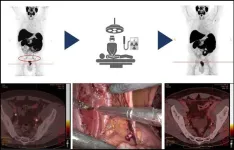(Press-News.org) In good news for office workers, a new study from the University of Sydney’s Charles Perkins Centre (Australia) has found increasing your step count may counteract the health consequences of too much sedentary time each day.
The study of over 72,000 people, published in the British Journal of Sports Medicine, found every additional step up to around 10,000 steps a day was linked to reduced risk of death (39 percent) and cardiovascular disease (21 percent) regardless of how much remaining time was spent sedentary.
Previous studies have shown an association between greater daily step count and lower levels of death and CVD, and separate studies have linked high levels of sedentary behaviour with increased risks of CVD and death. However, this is the first to objectively measure, via wrist-worn wearables, if daily steps could offset the health risks of high sedentary behaviour.
Lead author and research fellow, Dr Matthew Ahmadi said: “This is by no means a get out of jail card for people who are sedentary for excessive periods of time, however, it does hold an important public health message that all movement matters and that people can and should try to offset the health consequences of unavoidable sedentary time by upping their daily step count.”
Senior author Professor Emmanuel Stamatakis, Director of the Mackenzie Wearables Research Hub at the Charles Perkins Centre, said this growing body of physical activity research using device-based measurement provided huge opportunities for public health.
“Step count is a tangible and easily understood measure of physical activity that can help people in the community, and indeed health professionals, accurately monitor physical activity. We hope this evidence will inform the first generation of device-based physical activity and sedentary behaviour guidelines, which should include key recommendations on daily stepping,” said Professor Stamatakis.
How was the study conducted?
Researchers used data on 72,174 individuals (average age 61; 58% female) from the UK Biobank study - a major biomedical database - who had worn an accelerometer device on their wrist for seven days to measure their physical activity. The accelerometer data were used to estimate daily step count and time spent sedentary, that is sitting or lying down while awake.
The research team then followed the health trajectory of the participants by linking hospitalisation data and death records.
The median daily step count for participants was 6222 steps/day, and 2200 steps/day (the lowest 5 percent of daily steps among all participants) was taken as the comparator for assessing the impact on death and CVD events of increasing step count.
The median time spent sedentary was 10.6 hours/day, so study participants sedentary for 10.5 hours/day or more were considered to have high sedentary time while those who spent less than 10.5 hours/day sedentary were classified as low sedentary time.
Adjustments were made to eliminate biases, such as excluding participants with poor health, who were underweight or had a health event within two years of follow-up. Researchers also took into account factors such as age, sex, ethnicity, education, smoking status, alcohol consumption, diet and parental history of CVD and cancer.
What did they find?
Over an average 6.9 years follow up, 1633 deaths and 6190 CVD events occurred.
After taking account of other potential influences, the authors calculated that the optimal number of steps per day to counteract high sedentary time was between 9000 to 10000 steps/day, which lowered mortality risk by 39 percent and incident CVD risk by 21 percent.
In both cases, 50 percent of the benefit was achieved at between 4000 and 4500 steps a day.
Study limitations
This is an observational study so can’t establish direct cause and effect. And although the large sample size and long follow-up allowed the risk of bias to be reduced, the authors acknowledge the possibility that other unmeasured factors could affect results. As steps and sedentary time were obtained in a single time point, this could also lead to bias, they add.
Nevertheless, they conclude, “Any amount of daily steps above the referent 2200 steps/day was associated with lower mortality and incident CVD risk, for low and high sedentary time. Accruing between 9000 and 10,000 steps a day optimally lowered the risk of mortality and incident CVD among highly sedentary participants.”
END
Daily step count of 9,000 to 10,000 may counteract risk of death and cardiovascular disease in highly sedentary people
Increased step count linked to lower risk regardless of time spent sedentary
2024-03-06
ELSE PRESS RELEASES FROM THIS DATE:
Novel device for stomach complaints has successful human trial
2024-03-06
The endoscopic mapping device, developed over more than a decade by scientists at the Auckland Bioengineering Institute, consists of an inflatable sphere covered in sensors, delivered down the oesophagus and able to measure electrical activity in the gut.
In the same way abnormal heart electrical signals can cause serious heart problems, so research has found faulty bioelectric gut waves can lead to stomach pain, nausea, vomiting and bloating.
But often doctors can’t find out what the problem is. ...
Oregon State researchers make key advance toward removing pesticide from groundwater
2024-03-06
CORVALLIS, Ore. – Scientists led by an Oregon State University chemistry researcher are closing in on a new tool for tackling the global problem of weedkiller-tainted groundwater.
Kyriakos Stylianou of the OSU College of Science led an international team that identified a material known as a metal-organic framework, or MOF, that showed an ability to completely remove, and also break down, the oft-used herbicide glyphosate.
The MOF, one of four tested in a collaboration among scientists from Oregon State and Tiangong University in China, is based on scandium, chemical symbol Sc, ...
UTEP clinical trial to encourage healthy walking habits
2024-03-06
EL PASO, Texas (March 5, 2024) – Health researchers at The University of Texas at El Paso are launching a clinical trial to improve walking in the El Paso community, thanks to a $4.4 million grant from the National Institutes of Health (NIH). The project will enroll local school district employees in 50K 4 Life, a program that challenges them to improve their health by walking at least 50,000 steps per week.
“This is an exciting opportunity to improve our community’s health through the simple, free and life-changing ...
Research explores the cooling effects of ‘scuba-diving’ in lizards
2024-03-06
BINGHAMTON, N.Y. -- Anoles are the scuba-diving champions of the lizard world, able to stay underwater for more than 16 minutes. For animals whose body temperature depends on the environment, time spent in a cool running stream can have some tradeoffs, according to new research from Binghamton University, State University of New York.
A recent study by Binghamton University doctoral candidate Alexandra M. Martin, Christopher K. Boccia of Queens University in Canada, and Binghamton University Assistant Research Professor of Biological Sciences Lindsey ...
Gender gap on Wikipedia
2024-03-05
Since it was created in 2001, Wikipedia has become a key element of the modern public sphere, which has revolutionized the way we create and share information. However, it has defects when it comes to its decentralization and flexibility, specially regarding inclusion and diversity.
Some gender biases that stand out are shown in its content and its editorial participation. It has a low percentage of women’s biographies and an unequal representation in editing. Also, there are gaps in the gender representation regarding its content, biases in editing and participation, as well as imbalances in readership.
These ...
Scientists to study real-world eating behaviors using wearable sensors and artificial intelligence
2024-03-05
A pedometer measures your steps, but what if you had a similar automated device to measure your eating behavior? Evidence from nutritional studies has long shown that the speed, timing and duration of an individual’s eating behavior are strongly related to obesity and other health issues. While eating behaviors can be accurately measured in a controlled laboratory setting, a blind spot exists when researchers attempt to study how participants actually eat “in the wild.”
A new National Institutes ...
Radioguided surgery accurately detects and removes metastatic lymph nodes in newly diagnosed prostate cancer patients
2024-03-05
Reston, VA — Radioguided surgery can detect and remove metastatic pelvic lymph nodes in patients newly diagnosed with prostate cancer, according to research published in the March issue of The Journal of Nuclear Medicine. Targeting the prostate-specific membrane antigen (PSMA), which is overexpressed in most prostate cancer patients, radioguided surgery can improve nodal staging to guide treatment recommendations for this important patient population.
In newly diagnosed prostate cancer patients, nodal involvement correlates with recurrence, and determining if lymph node metastases are present and where they ...
Aluminum nanoparticles make tunable green catalysts
2024-03-05
HOUSTON – (March 5, 2024) – Catalysts unlock pathways for chemical reactions to unfold at faster and more efficient rates, and the development of new catalytic technologies is a critical part of the green energy transition.
The Rice University lab of nanotechnology pioneer Naomi Halas has uncovered a transformative approach to harnessing the catalytic power of aluminum nanoparticles by annealing them in various gas atmospheres at high temperatures.
According to a study published in the Proceedings of the National Academy of Sciences, Rice ...
Electrolyte cation types control electrochemical reactions on an electrode surface
2024-03-05
1. An international research group consisting of NIMS and the Finnish University of Jyväskylä has discovered through its electrode-electrolyte system research that electron and proton (i.e., hydrogen ion) transfer mechanisms during oxygen reduction reactions (ORRs) on electrode surfaces vary depending on the types of cations dissolved in the electrolytic solution. These results suggest that the energy conversion efficiencies and selectivity of electrochemical systems (e.g., fuel cells and water electrolysis hydrogen production systems) can be improved by selecting optimal reaction pathways and that this could be achieved without using expensive electrode ...
The dangers of misaligned product co-development contracts—and how they can derail innovation in high-tech firms
2024-03-05
Researchers from Mansoura University and University of Guelph published a new Journal of Marketing study that examines how misaligned contracts can erode innovation outcomes of high-tech firms.
The study, forthcoming in the Journal of Marketing, is titled “Collaborating to Innovate: Balancing Strategy Dividend and Transactional Efficiencies” and is authored by Nehal Elhelaly and Sourav Ray.
When a giant multinational like Unilever partners with one of its major suppliers, such as the industrial enzyme-producer Novozyme, the collaboration can fast-track ...
LAST 30 PRESS RELEASES:
NTP-enhanced lattice oxygen activation in Ce-Co catalysts for low-temperature soot combustion
Synergistic interface engineering in Cu-Zn-Ce catalysts for efficient CO2 hydrogenation to methanol
COVID-19 leaves a lasting mark on the human brain
Scientists use ultrasound to soften and treat cancer tumors without damaging healthy tissue
Community swimming program for Black youth boosts skills, sense of belonging, study finds
Specific depressive symptoms in midlife linked to increased dementia risk
An ‘illuminating’ design sheds light on cholesterol
Who is more likely to get long COVID?
Study showcases resilience and rapid growth of “living rocks”
Naval Research Lab diver earns Office of Naval Research 2025 Sailor of the Year
New Mayo-led study establishes practical definition for rapidly progressive dementia
Fossil fuel industry’s “climate false solutions” reinforce its power and aggravate environmental injustice
Researchers reveal bias in a widely used measure of algorithm performance
Alcohol causes cancer. A study from IOCB Prague confirms damage to DNA and shows how cells defend against it
Hidden viruses in wastewater treatment may shape public health risks, study finds
Unlock the power of nature: how biomass can transform climate mitigation
Biochar reshapes hidden soil microbes that capture carbon dioxide in farmland
Reducing saturated fat intake shows mortality benefit, but only in high-risk individuals
Manta rays create mobile ecosystems, study finds
Study: Mixed results in using lipoic acid to treat progressive multiple sclerosis
Norbert Holtkamp appointed director of Fermi National Accelerator Laboratory
New agentic AI platform accelerates advanced optics design
Biologists discover neurons use physical signals — not electricity — to stabilize communication
Researchers discover that a hormone can access the brain by hitchhiking
University of Oklahoma researcher awarded funding to pursue AI-powered material design
Exploring how the visual system recovers following injury
Support for parents with infants at pediatric check-ups leads to better reading and math skills in elementary school
Kids’ behavioral health is a growing share of family health costs
Day & night: Cancer disrupts the brain’s natural rhythm
COVID-19 vaccination significantly reduces risk to pregnant women and baby
[Press-News.org] Daily step count of 9,000 to 10,000 may counteract risk of death and cardiovascular disease in highly sedentary peopleIncreased step count linked to lower risk regardless of time spent sedentary






